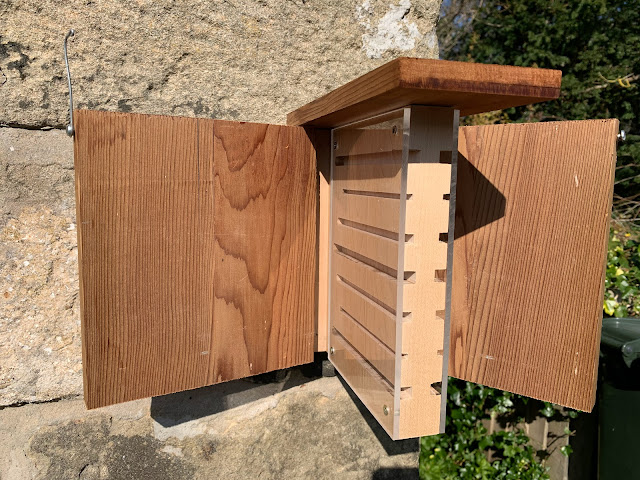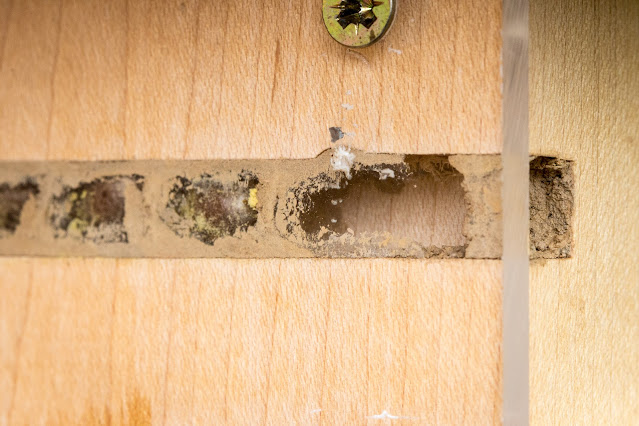Red mason bees have been the most reliable occupants of my bee houses. Early in the year I made a new double-sided observation house and fixed it in a south-facing position on the garage wall. It has a choice of 4mm, 6mm and 8mm holes.
The first red mason bee I saw this year was a male on 25th March, inspecting holes in a dead sycamore in the meadow.
The next day a female had moved into the bee house, although it was another month before she (or another bee) started building. There were eventually three bees using the bee house as a roost or shelter.
The weather was pretty cold in early April and presumably discouraged the bees. This one is keeping warm in one of the 8mm holes.
Here she is standing at the entrance, sniffing what is going on outside with her antennae.
Here is a bee working on the first cell on 29th April. She has partly built the cell wall and is head first in the cell regurgitating nectar onto the pile of pollen. She then turned round and scraped pollen off the scopa (pollen brush) on the underside of her abdomen. Once the provisioning was complete she laid an egg and closed up the partition wall with mud before moving on to the next cell.
In the older bee house here is another bee regurgitating nectar,
and unloading pollen,
before trudging back along the hole and setting off on yet another foraging trip.
On 10th May I witnessed an extraordinary wrestling match between two females in the new bee house. It was already underway when I opened up to have a look and went on for several minutes, long enough for me to fetch a camera and then go back for a tripod. I think what had happened was that one bee had gone into the wrong hole and was met by the rightful owner as she tried to leave. There wasn't room to pass and so the struggle ensued.
Red masons seem to prefer the 8mm holes because they can turn round inside them, which makes life easier as they have to unload the nectar while facing forwards and the pollen while facing outwards. They will use 6mm holes but have to reverse to the entrance each time and turn around before reversing back in.
This bee completed 12 cells and finished off with a mud wall at the entrance with a small empty cavity behind. The smaller front cells will produce male bees which emerge first and the females are in the larger cells behind.
Here is a larva which has eaten almost all the food and looks ready to spin its cocoon.
In the new bee house the top two and bottom two holes were all finished by mason bees but within days a bird, probably a blue tit or a great tit, came along and pecked out the mud in the hope of finding something to eat behind.
The bird was thwarted by the spaces behind and the inner walls were not breached.
Since then I have put on a bird-proof, bee-friendly mesh to protect the bees.
Other nests were completed elsewhere in the bee houses.
This year's red mason bees are now all dead and their offspring are developing in the bee houses. Within a few weeks the bees will be mature within their cocoons but they will wait inside until next March before emerging to start the whole cycle over again. Other things also built nests in the bee house and I'll post news of them shortly.


















No comments:
Post a Comment